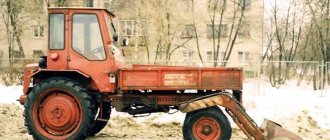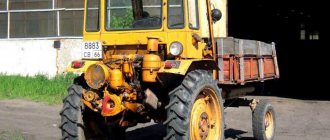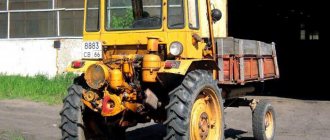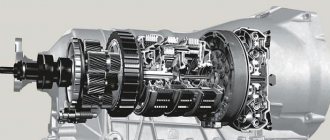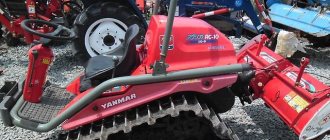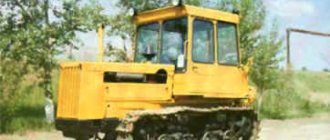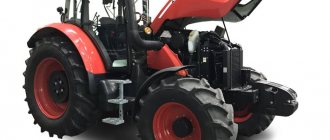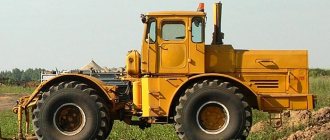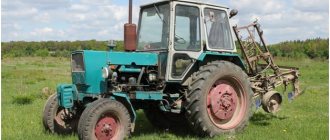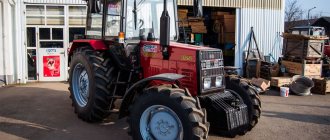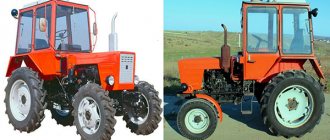For more than 30 years, from 1961 to 1995, the Kharkov Self-Propelled Tractor Chassis Plant produced the T-16 tractor. It is still actively used by farmers today: used as an excavator, loader, bulldozer, for mowing, hilling potatoes and vegetables, transporting goods and even plowing. Unlike conventional farm tractors, the T-16's engine and transmission are located in the rear, and the front is an open tubular frame designed to mount implements. This design allows the tractor driver to clearly see the working parts of the mounted implements between the rows.
Compactness, good maneuverability, maneuverability and simplicity of design have led to the fact that today equipment owners continue to independently modernize this machine. For example, they attach a plow, a row-crop cultivator, a seeder, and a potato digger. Craftsmen install a front drive axle and a mechanical winch on the T-16, which further increases the tractor's cross-country ability.
The design of the T-16 tractor was based on the DSSh-14 self-propelled chassis, which was produced at the Kharkov Self-Propelled Tractor Chassis Plant (Ukraine) from 1961 to 1967, and the tractor also began to be produced here. Almost 600 thousand of these cars were produced. Until now, rural residents use the T-16 for procurement and household work, and it is in great demand.
Topic of the week #49. Tractor upgrade - T16.
And this is what it looks like after the master’s hands:
As you can see, the master added handles to the doors and the cabin and replaced the wiper:
Once again I am convinced that such a small thing as a registration mark has a very positive effect on the perception of the model: The cargo in the “beggar” box is included in the “set” of modifications.
Power system
The T-16 “Chassik” tractor is equipped with a four-stroke, 2-cylinder diesel engine D16, which is cooled by air. A special feature of the engine is that mixture formation occurs in a pre-chamber manner. The power system is represented by a crank mechanism, a gas distribution device, a power system, lubrication, cooling and starting systems.
The fixed base of the engine is the crankcase. An aluminum cover is attached to its front part. A flywheel casing was installed on the back of the housing part, and oil filters were attached to the bottom. The crankcase also provided for the location of the camshaft. The bottom of the crankshaft support is where the oil pump is installed.
Front axle of the YuMZ tractor
The front axle of the YuMZ tractor is a swinging cast tubular beam with split ends.
The beam, with its tides, is connected through the swing axis to the eyes of the front beam of the tractor frame. The swing axis is secured against axial movements and rotation in the front beam with a wedge-shaped bolt. At both ends, retractable fists are inserted into the beam, consisting of a bracket and a pipe welded together. The pipe has six holes at 50 mm intervals for the clamp. This makes it possible to obtain six positions of the retractable cam in the main pipe. Each of these positions corresponds to a specific track of the guide wheels. The pipe is clamped in the beam with coupling bolts.
In the bracket of the retractable knuckle, a rotary axle is installed on two bushings and a thrust ball bearing, into which the front wheel axle shaft is pressed. The cavity of the bushings and bearing is sealed at the bottom with two rubber rings, and at the top with a rubber ring and a felt seal. On the upper ends of the swivel axles of the YuMZ front axle, swivel arms are mounted on splines and secured with coupling bolts. The levers are pivotally connected through transverse and push rods to a central lever mounted on the steering lever, connected through a longitudinal rod to the steering. The length of the transverse and push rods is adjustable, which is necessary when changing the track and adjusting the toe-in of the guide wheels. The steering lever rotates on two bronze bushings mounted in the boss of the beam. In the upper part, the lever shaft is sealed with a rubber seal, and in the lower part with a felt seal.
Front axle of the YuMZ tractor: 1 - bracket; 2 and 27 — rotary levers; 3 - pipe; 4 — clamp; 5 - bolt; 6 - beam; 7 — swing axis; 8 - tide; 9 — steering lever; 10, 19 and 22 - oilers; 11—longitudinal thrust; 12 - spring; 13 - rubber coupling; 14 — liner; 15 — overlay; 16 — adjusting plug; 17 — ball pin; 18 — emphasis; 20 - oil seal; 21 and 24 — rubber rings; 23 - ball bearing; 25 — axle shaft; 26 — rotary axle; 28 — hinge plug; 29 — lower liner; 30 — ball joint pin; 31 — upper liner; 32 — sealing cover; 33 — push rod; 34 — central lever; 35 — tip hinge; 36 - transverse thrust.
The angle of rotation of the guide wheels of the YuMZ front axle is limited by the angle of rotation of the steering lever, which, when turning, rests against the boss on the axle beam. The designs of the joints of the transverse and push rod ends are the same. The ball joint pin rotates in two liners: the upper one made of polyamide and the lower one made of rubber. The liners are pressed against the head of the pin by an adjusting plug, wrapped in the tip body and held from unscrewing by a cotter wire. The hinge is lubricated with lubricant placed into it during assembly. The hinge is protected from dust and water by a rubber sealing cover.
The ball pin of the longitudinal steering rod hinge rotates in two steel liners, pressed against the head of the pin by a spring pressed by an adjusting plug. In the rod heads, the springs relative to the ball pins are located so that the force acting on the rod, depending on its direction, is transmitted only through one spring. To protect the spring from breakage, which is possible during strong shocks, its compression is limited by a stop.
The longitudinal steering rod joints are lubricated through oil nipples wrapped in the rod. The hinges are protected from dust and moisture by rubber couplings with linings.
Modifications, improvement processes
As a result of repeated improvements, the SS was equipped with a diesel engine, which was cooled by air. The power plant was distinguished by power - 25 hp. A new gearbox and frame cabin were installed on the unit - it was already a T-16M tractor. Thanks to the increased wheel size, the vehicle now has a greater load capacity. We changed the hydraulic system and improved the chassis.
How much the T-16 tractor weighs depended on the configuration. The first unit weighed 1670 kg. The weight of the modification became minus 200 kg. The ability to install a wide variety of attachments made it possible to operate the machine for road marking work and as a snow clearer.
The latest modification of the SSh - T-16MG, 1995 was the last year of production of this equipment. Further, only its owners take part in the improvement process. The main goal is to create a universal version of attachments.
tractor t-25 | Topic author: Nadezhda
Tell me where are the serial numbers for T 25 and how many are there?
To register the tractor. Alexander (Alaric) I registered that year, head.
The number must be on aluminum. on the plate near the battery compartment on the right side along the route. The engine number is also on the right only on the block below, also on the aluminum plate.
Dayan (Hasiba) on the block itself at the back between the battery and the engine cylinder and in the box on the right side there are no signs
Dayan (Hasiba) and at the back where the hydraulic tank is
Alexander (Alaric) I don’t know, these engine numbers and the serial number were written down in the technical passport. You can also find a video on the Internet, they will show everyone where everything is, now this is not a problem!
Dayan (Hasiba) find it
Alexander (Alaric)
Dmitry (Lenhart) go to the starter from the left plate cabin number under the starter engine number above the oil pumps box number stamped
Dayan (Hasiba) is in two more places
Tags: Where is the serial number located on the T-16 tractor
What can be made from a T-16 tractor
Many owners have tried to create a universal rear hydraulic linkage for attaching agricultural implements. The unit performed the functions of: a plow, a row-crop cultivator, a seeder, a potato digger, and a hiller. The modification of the T-16 tractor was carried out with our own hands, at home. The hitch makes it possible to use the unit as a front loader, a grab installation, or a mounted lifting mechanism. The machine can also perform the functions of an excavator and loader, which is used to transport trees.
The tractor becomes indispensable for cargo transportation in an ordinary or dump trailer. How to improve cross-country ability? Due to the chassis with a front drive axle and the installation of a mechanical winch. The machine, although not possessing serious power and functionality, copes well with its scope of work.
Tractors in the Museum of Tractor History (Cheboksary)
Excursion to the Museum of Tractor History (Cheboksary). Today is the end. Only tractors. View only for those who are interested
1. T-28 - brand of wheeled tractor produced by the Vladimir Tractor Plant from 1958 to 1964
2. DT-20 - a brand of wheeled tractor produced by the Kharkov Tractor Plant from 1958 to 1969 3. HTZ-7 - a universal garden tractor produced by the Kharkov Tractor Plant from 1950 to 1956. The first Soviet small-sized tractor 4. T-5 (I couldn’t find information about the model) 5. T-38 - a universal row-crop crawler tractor produced from 1958 to 1973 (including the T-38M modification) by the Vladimir and Lipetsk tractor plants 6. KD-35 - a row-crop crawler tractor produced from 1947 to 1960 by the Lipetsk Tractor Plant, since 1950 by the Minsk Tractor Plant and since 1951 by the Brasov Tractor Plant (Brasov, Romania). KD stands for “Kirov Diesel” 7. DT-75 is a general-purpose tracked agricultural tractor. The most popular caterpillar tractor in the USSR (today more than 2.7 million copies). In 2008, the Volgograd Tractor Plant celebrated the 45th anniversary of the start of production of the DT-75. The tractor has acquired a good reputation thanks to a successful combination of good performance properties (simplicity, efficiency, maintainability) and low cost compared to other tractors in its class
8. LTZ-120 - wheeled universal row-crop tractor. LTZ - Lipetsk Tractor class=»aligncenter» width=»640″ height=»427″[/img] 9. SHTZ 15/30 is a brand of wheeled tractor produced since 1930 by the Stalingrad Tractor Plant and since 1931 by the Kharkov Tractor Plant. 390 thousand tractors were produced. Production ended in 1937
10. KhTZ-7 11. T-150 and T-150K brands of universal high-speed tractors produced by the Kharkov Tractor Plant. The T-150 tractor has a tracked drive, and the T-150K has a wheel drive. Historically, the wheeled version (T-150K) of the tractor was made later and on the basis of the tracked one, but became much more widespread 12. DT-20 13. Homemade tractor and T-16 (in the background). T-16 was often used in the housing and communal services sector
14. DT-54 - general-purpose tracked agricultural tractor. The tractor was produced from 1949 to 1963 by the Stalingrad Tractor Plant, from 1949 to 1961 by the Kharkov Tractor Plant, from 1952 to 1979 by the Altai Tractor Plant. Total 957,900 units built
15. T-74 - Soviet tracked tractor with a traction class of 3 tons, produced by the Kharkov Tractor Plant. Created by modernizing the DT-54, T-75 tractors. The tractor is designed to perform agricultural and transport work in regions with a temperate climate. Produced from April 1962 to November 24, 1983 16. MTZ-50 “Belarus” - a brand of general purpose wheeled tractors produced by the Minsk Tractor Plant from 1962 to 1985
17. T-4, T-4A, T-4AP - brands of tracked tractors produced by the Altai Tractor Plant. The T-4 tractor was produced from 1964 to 1970
18. Fordson-Putilovets is a wheeled tractor produced in Leningrad since 1924 under license from the Ford company. It was a copy of the American Fordson-F 19 tractor. John Deere B
20. SHTZ-15/30
21. McCormick-Deering 10-20 tractor (1930)
22. McCormick (exact model unknown) 23. Station wagon - an agricultural tractor produced at Leningradsky from 1934 to 1940. and at the Vladimir Tractor Plant from 1944 to 1955. The Universal U-2 tractor was the first tractor produced at the Vladimir Tractor Plant. Also, the Universal tractor was the first Soviet tractor supplied from the USSR for export 24. John Deere A
25. T-28 “Vladimirets”
Advantages and disadvantages
To replace spare parts, make a trailer or install a hitch, you don’t need to make any effort. Tractor maintenance and repairs are inexpensive for the owner. Many specialized markets sell components, attachments and trailed equipment.
Difficulties arise during repairs when it is necessary to remove the release bearing and replace the differential. This is a labor intensive process as each sleeve must be removed. To do this, the cabin is removed or limited to installing a stand under it. Then the primary and secondary shafts are removed, which will require disassembling the entire box. The lock housing is being removed. The left bearing cover is knocked inward. The differential is removed and the bearings and seals are replaced.
